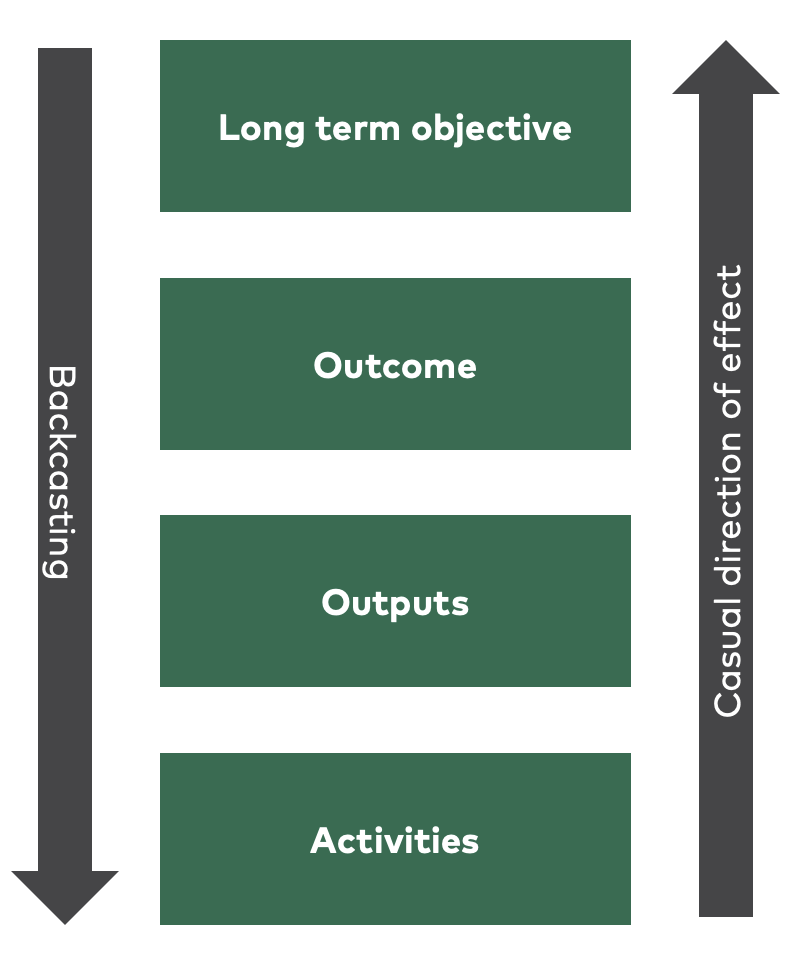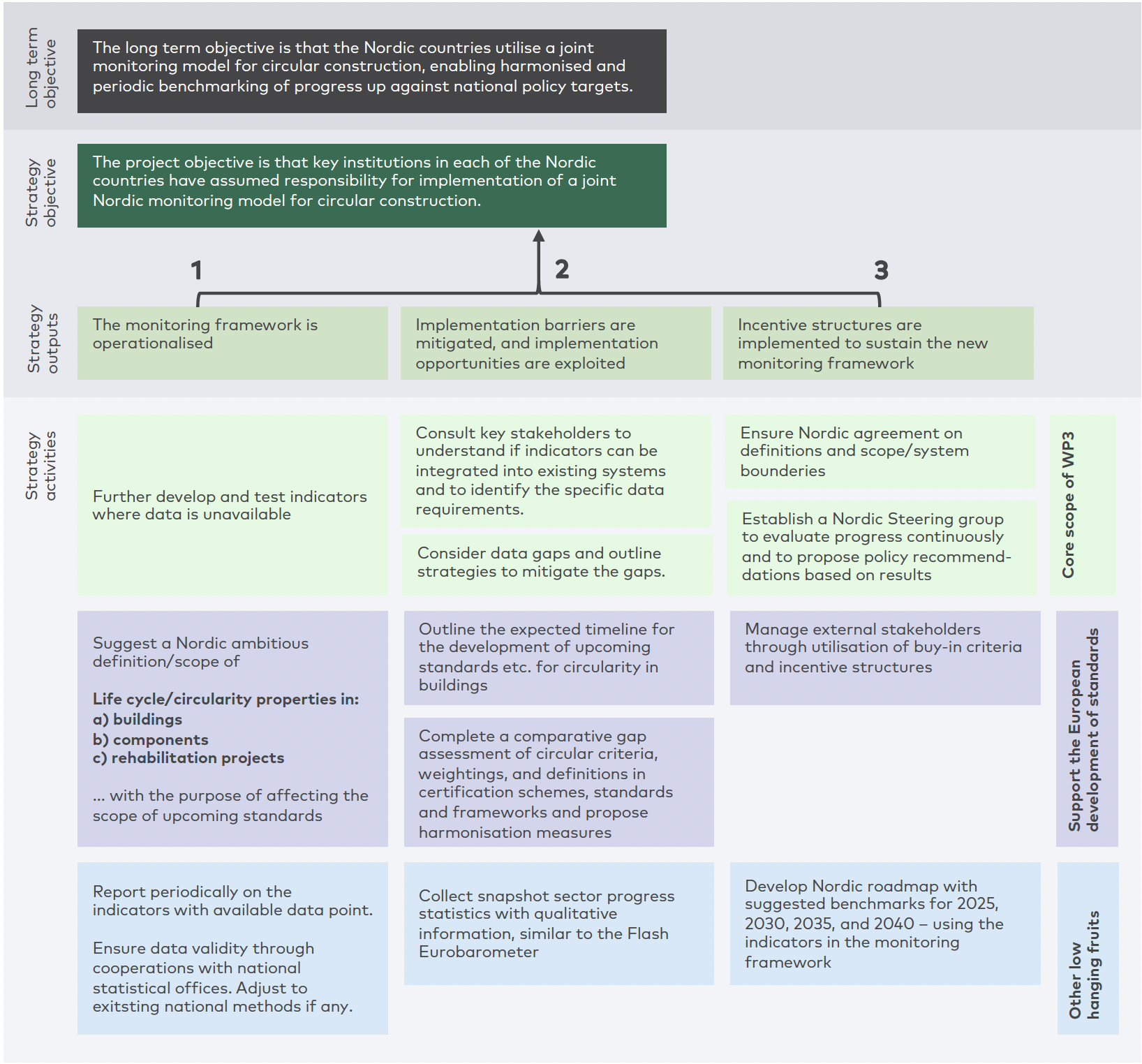DRAFT STRATEGY FOR IMPLEMENTATION OF THE NEW MONITORING FRAMEWORK
The following section conceptualises the findings collected throughout the WP3 project within an action plan for implementing the shortlisted indicators in the Nordics.
The strategy is structured according to the Logical framework approach (LFA), which emphasises the need to thoroughly understand the problem to be solved and define the intended impact before formulating project activities (Norad, 2015). Developing the strategy can, therefore, be described as a back-casting exercise.
The following section describes each element in the strategy.


Long term Objective
Breaking down the objective reveals aspirations toward aligning methodologies, definitions, and policy benchmarks for policy efforts specifically for material efficiency in the Nordics. This vision is closely related to the Nordic Council of Ministers’ vision of becoming the most integrated region in the world.
A vital aspect of the long-term objective is ensuring the actual utilisation of the monitoring model. In other words, the monitoring framework is only a success if used. This underlines the need to allocate responsibility and resources to post-implementation practices such as evaluation, reporting, and maintenance. The long-term objective is reflected in the formulation of the project objective below:
Strategy Objective
The strategy objective establishes that a successful outcome relies on coordination and collaboration between the Nordics. Key institutions include statistical offices, municipalities, ministries, and industry associations. To ensure national implementation and ownership, the implementation must accommodate the differences in the Nordic sectors and policy landscapes.
The monitoring framework will provide reliable and valuable information to policymakers and other relevant stakeholders in the construction sector. This will enable informed decisions, including policy corrections, to ensure the realisation of long-term policy targets for circular construction.
Strategy Outputs
The strategy objective will be achieved through the delivery of three outputs:
Output 1 aims to prepare and test the monitoring framework in cooperation with national stakeholders, ensuring that the indicators provide relevant and reliable information for key stakeholders.
Output 2 ensures that the implementation strategy is pragmatic towards barriers and opportunities to ensure effective implementation. The WP3 has already assessed such barriers and opportunities.
Output 3 allocates resources to evaluate, maintain, and adapt the monitoring framework to future needs. Output three contributes to building ownership over the framework at relevant institutions.
Strategy Activities
The three outputs will be delivered based on a series of activities.
Output | Activity | Explanation |
Output 1: The monitoring framework is operationalised | 1.1 Further develop and test indicators where data is unavailable | This activity focuses on refining and operationalising two less widespread indicators: Utilisation rate and Total renovations vs demolition and new buildings. This activity defines which metrics are most helpful and what possible implications new indicators may have. The testing phase includes data collection, cleaning, and interpretation. Finally, the data collection must be implemented in collaboration with municipalities and statistical officers. |
1.2 - Suggest a Nordic ambitious definition/scope of Life cycle/circularity properties in: a) buildings, b) components, and c) rehabilitation projects ... to affect the scope of upcoming standards. | Since several working groups (e.g., certification schemes and standardisation organisations) are already working on defining building life cycle properties, implementing new Nordic metrics may not contribute to the overall cause of harmonisation and integrity. Instead, the mandate of the Nordic Council of Ministers is to support these ongoing standardisation processes. By representing society as a whole rather than the industry, the Nordic Council of Ministers has a mandate to improve the level of ambition, e.g., by influencing these processes by suggesting metrics and measuring methodologies that reflect the most significant effect on the environment. | |
1.3 Report periodically on the indicators with available data point. Ensure data validity through cooperations with national statistical offices. Adjust to exitsting national methods if any. | This task seeks to improve data quality, coherence, and reliability of Nordic building information on readily available databases such as Eurostat. These databases can then be utilised to provide reports based on a number of the shortlisted indicators. | |
Output 2: Implementation barriers are mitigated, and implementation opportunities are exploited | 2.1 - Consult key stakeholders to understand if indicators can be integrated into existing systems and to identify the specific data requirements. | Task 2.1 ensures collaboration with existing databases and data collectors. Key stakeholders include statistical officers and building permit officers. These are consulted to ensure that existing procedures and data requirements are adhered to. Furthermore, collaboration towards new data collection may be established by engaging in dialogue with such stakeholders. |
2.2 - Consider data gaps and outline strategies to mitigate the gaps. | Task 2.2 establishes mitigating strategies for managing identified data gaps and other implementation barriers. This is especially relevant for the less widespread indicators such as the utilisation rate. Here, metrics may only be available for specific building types, etc. | |
2.3 - Outline the expected timeline for developing upcoming standards for circularity in buildings. | Task 2.3 ensures that the timing of subtasks within task 1.2 is appropriate in relation to the ongoing development of new circularity criteria and standards. It outlines critical events and possible pathways of influence. | |
2.4 - Complete a comparative gap assessment of circular criteria, weightings, and definitions in certification schemes, standards and frameworks and propose harmonisation measures | Task 2.4 investigates the potential to harmonise circular criteria, weightings and definitions across certification schemes, enabling the sector to identify hotspots for improvements. This activity also serves as a public service by providing a general overview of the sector over the ambition of circularity criteria across available certification schemes. Furthermore, this activity feeds into task 1.2 by providing a foundation for suggesting new criteria. | |
2.5 - Collect snapshot sector progress statistics with qualitative information, similar to the Flash Eurobarometer | Task 2.5 represents an alternative reporting approach with the potential to substantiate more in-depth snapshots about the sector. Rather than a dashboard approach with statistical information, there is the option to operate regional surveys on an organisational level. This activity can provide critical information to support official statistics inspired by the European Flash Eurobarometer (EC, 2022a). | |
Output 3: Incentive structures are implemented to sustain the new monitoring framework. | 3.1 - Ensure Nordic agreement on definitions and scope/system boundaries. | Task 3.1 engages in dialogue with Nordic policymakers to ensure a consensus-based approach to implementing the indicators and provide an arena for influencing the monitoring framework. While this is an important feedback mechanism, it is also an essential prerequisite for the uptake of national ownership. |
3.2 - Establish a Nordic Steering group to evaluate progress continuously and to propose policy recommendations based on results. | Task 3.2 established a Nordic Steering group to bridge the monitoring results with policymaking through evaluations, policy recommendations, quarterly sector reports, etc. A steering group with monitoring responsibility serves to help translate the statistical findings into useful findings, thereby improving the utilisation of the framework. | |
3.3 - Manage external stakeholders through the utilisation of buy-in criteria and incentive structures. | Task 3.3 continuously engages with sector stakeholders to ensure the framework is current with perceived needs. | |
3.4 - Develop a Nordic roadmap with suggested benchmarks for 2025, 2030, 2035, and 2040 - using the indicators in the monitoring framework. | One major benefit of indicators is that they enable policy targets. Task 3.4 establishes ambitious voluntary Nordic benchmarks for each indicator. This can only be achieved through Nordic collaboration. |